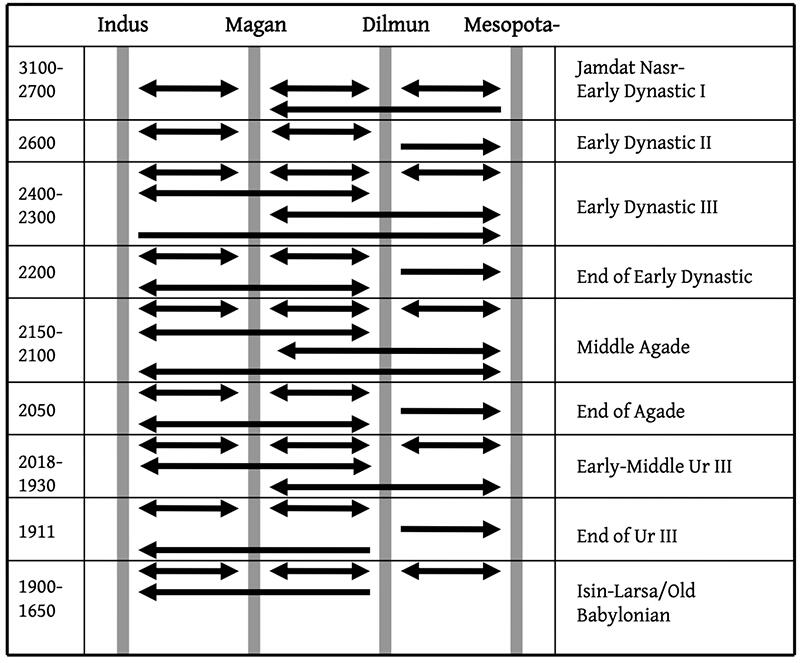"Recent work on Mesopotamian chronology supports the theory, maybe first proposed by Bibby (1970: 355), that long-distance trade between the two partners was initiated from the Indus," (p. 12) writes the author in this well-written, concise review of the context within which ancient Indus and Mesopotamian trade relationships took place in the second half of the third millennium BCE (roughly 2500-2000 BCE). One hesitates to use the word flourish, because these interactions seem to have been intermittent, and/or evidence is limited.
Reade does a nice job of describing the larger environment, like the so-called "Fish-eaters" described by ancient Greeks along the coast of Baluchistan, and the whole Mesopotamian-Gulf-Indus ecosystem in prehistoric times when, it seems, the mouths of the Indus and the Tigris and Euphrates would have been 1,000 km closer than they are now. Not that this was not the case in ancient Indus times (more like 15,000 years ago), but the physical environment and marshland was likely much more hospitable and amenable to smaller movements of "fish eaters" and goods in a huge coastal basin.
Reade also takes on Mesopotamian chronology, and shows how many of the dates we assume about that civilization are unconfirmed. If one accepts some of the new thinking on those dates it brings key Mesopotamian contacts closer to the height of the Indus civilization: "Sargon of Agade, the first Mesopotamian ruler to make a clear reference to Meluḫḫa — which can hardly be anywhere other than Baluchistan or the Indus area —, now belongs around 2300 or 2250 B.C. . . ." (p. 14).
The information he marshals lets him finally take on some of the myths around Indus-Mesopotamian relations, in particular that either significantly affected the development of the other: "Just as there is no need to look outside the Gulf for basic reasons underlying the development of Uruk urban civilisation in the 4th millennium, there is no need to look outside the Indus valley to explain the Indus civilisation. In both instances the urban population may have had very mixed origins, and there is a host of reasons including political leadership and environmental change which can be adduced as potentially relevant, but the basic reason for the emergence of these cities lies in the range and nature of local resources in the two river valleys (e.g. Possehl 1996)" (p. 15).
Then there was the advantage of water-borne transportation: "The Indus-Mesopotamia trade developed in part because ships had many advantages over caravans for the long-distance transport of products that were also theoretically available from alternative sources, and in part because, for some desirable products, there was no readily available alternative source" (p. 16). Another key point about the Gulf, which continuing excavations in the area are only reinforcing: "The well-known use of the Indus weight-system in Dilmun [Bahrain], and the Indus and Indus-derived script on some Gulf seals and probably on the copper stamp-seals of Indus shape in Oman (e.g. Reade 1995), demonstrate that the Indus was more influential in commercial relations than Mesopotamia. More and more Indus pottery is steadily being recognised at sites in Oman and the Gulf. Edens (1993: 354-355) notes the degree to which Indus products were imitated in Arabia" (p. 16).
He concludes with a typical broad view: "Potts (1993: 328) has noted the complicated patterns of trade attested in recent times, with the early 20th century use of Indian weights in central Arabia, and the surviving Mesopotamian texts may place too much emphasis on large-scale enterprise, at the expense of small-scale initiative. Fig. 3 [above] is offered as one possible model for the development and evolution of trading patterns between the Indus, Mesopotamia, and intervening areas of Magan and Dilmun. What would be most informative at this stage, as long anticipated (Rao 1988), is further excavation of harbour areas, and underwater survey to locate some of the hundreds of sunken cargoes which surely lie offshore" (p. 17).
Image: Fig. 3: The evolution of commercial expeditions between the Indus and Mesopotamia: one of many possible models suggesting the principal destinations of outward-bound ships. (Note: "Magan" is thought to refer to Oman, and/or possibly the Balochistan coast also called the Makran coast).
- Log in to post comments

